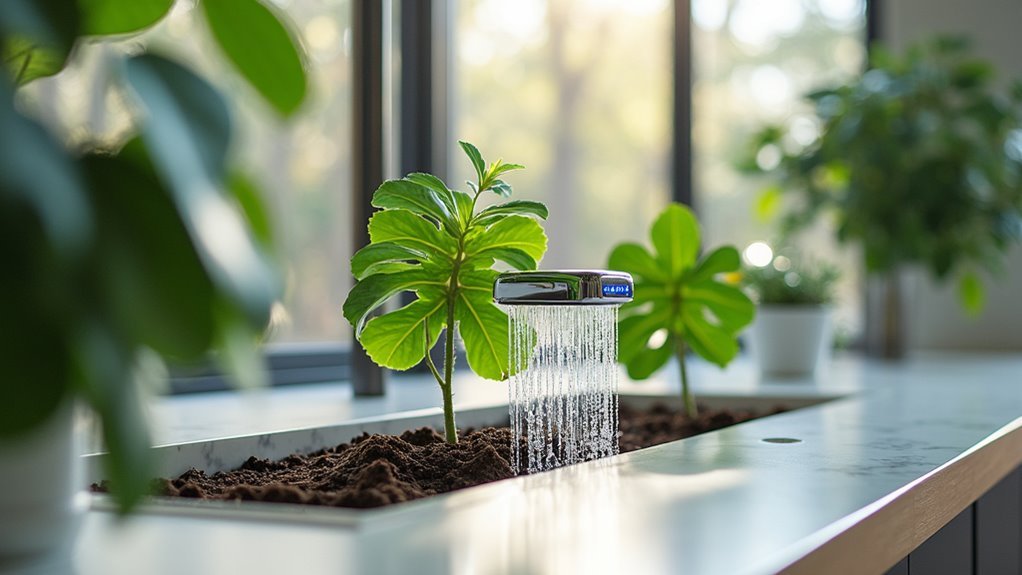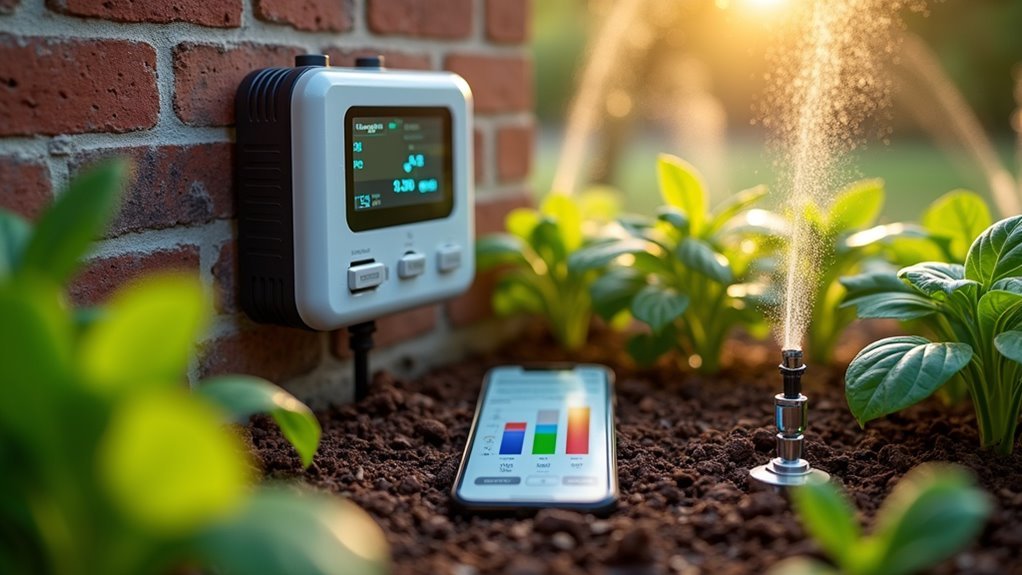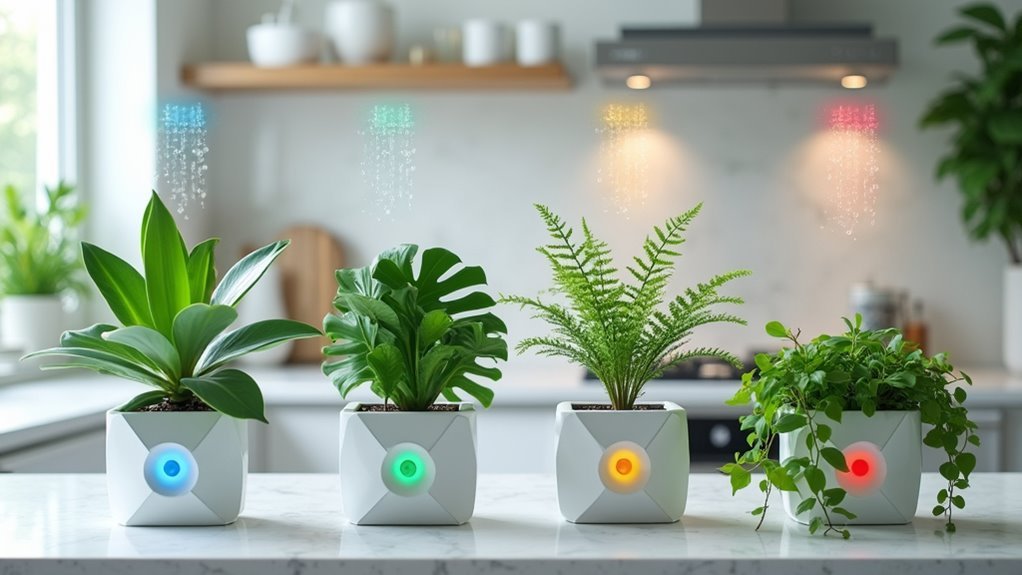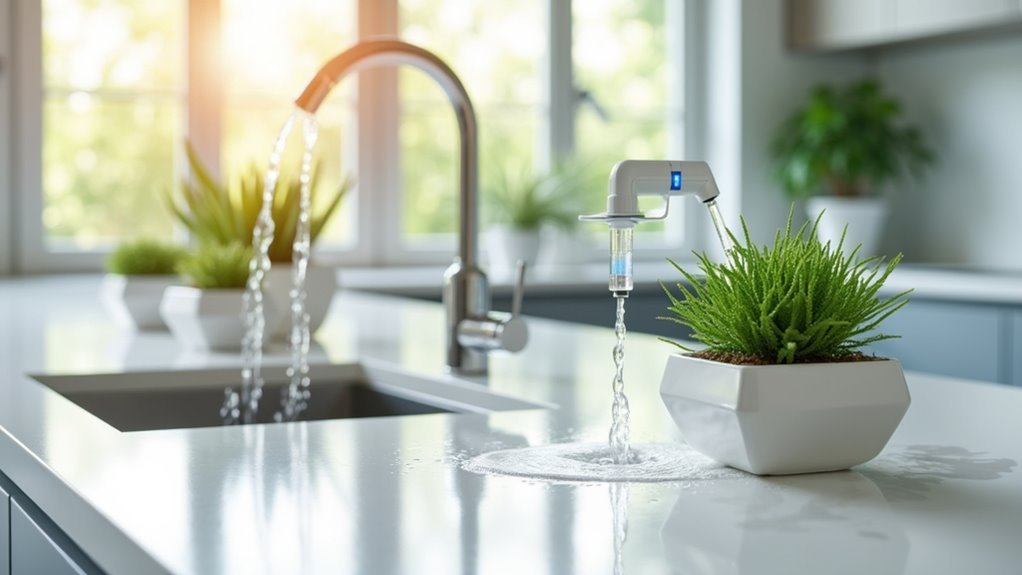You’ve probably watched your plants struggle through inconsistent watering routines, wondering if there’s a smarter way to keep them thriving without constant guesswork. Smart home technology now offers sophisticated solutions that monitor soil conditions, adjust for weather patterns, and deliver precise hydration automatically. However, creating the perfect automated watering schedule isn’t as simple as installing a few sensors and hoping for the best.
Understanding Smart Home Plant Watering Technology

Smart home plant watering technology transforms how you care for your indoor and outdoor plants by automating the entire irrigation process.
These automated irrigation systems utilize advanced sensors that continuously monitor soil moisture levels, ensuring your plants receive water precisely when needed. You’ll conserve water while promoting healthier plant growth through this targeted approach.
Smart watering systems integrate seamlessly with mobile apps, letting you monitor and control watering schedules remotely.
You’ll receive real-time alerts about your plants’ care needs and access valuable data on their health status.
Weather-equipped smart sprinklers adapt watering times based on environmental conditions, preventing overwatering during rainy periods.
Your system can even link to weather forecasts, automatically adjusting schedules according to temperature changes and rainfall predictions for ideal results.
Essential Components of Automated Irrigation Systems
Your automated irrigation system’s effectiveness depends on three critical components working together seamlessly.
You’ll need smart controller technology that processes data and makes watering decisions, sensor integration systems that monitor environmental conditions, and efficient water delivery methods that transport water directly to your plants.
Understanding how these elements interact will help you choose the right system for your smart home’s unique plant care needs.
Smart Controller Technology
When you’re building an automated irrigation system, the controller serves as the brain that orchestrates every watering decision.
Smart controllers revolutionize your watering approach by adjusting schedules based on real-time weather data, reducing water waste by up to 50% compared to traditional systems. You’ll benefit from soil moisture sensors that measure ground moisture levels, ensuring plants receive water only when needed.
Advanced systems integrate with mobile apps, letting you remotely monitor and control irrigation schedules from anywhere.
Rain sensors automatically suspend watering during rainfall, boosting water efficiency. When you combine smart controllers with drip irrigation technology, water delivers directly to plant roots, minimizing evaporation and runoff while maximizing efficiency for your smart home garden.
Sensor Integration Systems
Three essential sensor types work together to create a thorough monitoring network that eliminates guesswork from your plant watering routine.
Sensor integration systems combine soil moisture sensors, weather monitors, and rain detectors to enhance your irrigation performance. These soil moisture sensors deliver real-time data about your plants’ hydration needs, enabling customized watering schedules for different species in your garden.
Your system automatically adjusts to weather changes, incorporating rainfall and temperature data to reduce water usage by up to 70%.
Rain sensors prevent unnecessary watering during or after storms, maintaining ideal soil moisture while conserving water.
You’ll control everything remotely through mobile apps, receiving instant notifications about soil conditions and system performance. This intelligent monitoring guarantees your plants receive precise watering when they actually need it.
Water Delivery Methods
Modern automated irrigation systems offer four primary water delivery methods that maximize efficiency while meeting your plants’ specific hydration requirements.
Drip irrigation delivers water directly to plant roots, reducing waste by up to 70% compared to traditional watering methods. You’ll find smart sprinklers particularly effective as they use weather data to adjust schedules automatically, preventing overwatering during rainy periods.
These water delivery methods work seamlessly with soil moisture sensors to guarantee precise hydration timing.
Rainfall shutoff devices enhance conservation by temporarily disabling your system during precipitation. You can control everything through mobile apps, adjusting settings remotely for ideal plant care.
This integration creates a thorough automated irrigation system that conserves water while maintaining healthy gardens through intelligent, data-driven watering decisions.
Setting Up Soil Moisture Sensors for Accurate Readings
You’ll achieve the most accurate soil moisture readings by placing your sensors at the proper depth within your plants’ root zones, typically 4-6 inches deep for most garden plants.
Proper calibration guarantees your sensors provide reliable data, so you’ll need to test them in both dry and saturated soil conditions before installation.
Regular maintenance, including cleaning the probes and checking battery levels, keeps your sensors functioning effectively throughout the growing season.
Sensor Placement Depth Tips
When setting up soil moisture sensors for your smart home watering system, proper depth placement determines whether you’ll get accurate readings or misleading data that throws off your entire irrigation schedule.
For ideal sensor placement, position your soil moisture sensors within the root zone of your plants – typically 4-12 inches deep for garden plants and 6-12 inches for trees and shrubs.
Place sensors several inches away from plant stems and surface roots to prevent interference from surface moisture.
You’ll want to install multiple sensors at varying depths to understand moisture distribution throughout the soil profile. This thorough approach gives you better insights into your plants’ actual water needs, enabling your smart irrigation system to make precise watering decisions based on real conditions.
Calibration and Maintenance Steps
Once you’ve positioned your sensors correctly, proper calibration guarantees they deliver the reliable data your smart watering system depends on.
This essential process guarantees your soil moisture sensors provide accurate readings for peak plant care.
Follow these calibration and maintenance steps:
- Calibrate in dry soil first – Record the sensor’s baseline reading in completely dry soil
- Test in saturated conditions – Water the soil thoroughly and record the maximum moisture reading
- Set appropriate thresholds – Adjust settings to maintain 30-50% moisture levels for most houseplants
- Clean probes regularly – Remove soil buildup to prevent inaccurate readings and sensor malfunction
- Monitor battery life – Replace batteries promptly since low power affects sensor accuracy and reliability
Regular maintenance keeps your automated watering system running smoothly.
Programming Weather-Responsive Watering Schedules

Since traditional irrigation systems can’t adapt to changing weather conditions, programming weather-responsive watering schedules transforms your smart home’s plant care from guesswork into precision science.
Smart irrigation controllers integrate with weather forecasting services, automatically adjusting watering times and durations based on real-time data including temperature, humidity, and precipitation forecasts.
You’ll achieve ideal moisture levels while reducing water waste by up to 70%. These systems automatically suspend irrigation when rainfall’s detected, preventing overwatering and ensuring your plants receive exactly what they need.
Programming schedules to respond to local weather conditions maintains healthier plants while conserving water resources, leading to significant cost savings on your water bills.
Remote control via mobile apps lets you make adjustments based on changing weather patterns from anywhere.
Integrating Plant Care Apps With Home Automation
While weather-responsive systems handle outdoor conditions automatically, integrating plant care apps with your home automation takes indoor and outdoor plant management to the next level by creating a thorough ecosystem that monitors individual plant needs.
These sophisticated integrations transform how you’ll maintain your plants:
- Smart irrigation systems sync with apps like Happy Plant to execute personalized watering schedules based on each plant’s specific requirements.
- Real-time soil moisture monitoring lets you adjust watering remotely through your smartphone or tablet.
- Automated notifications eliminate guesswork by alerting you when plants need attention.
- Weather data integration enhances irrigation timing and frequency automatically.
- Water conservation features reduce waste by delivering precisely measured amounts.
This seamless connection between plant care apps and home automation simplifies maintenance while ensuring ideal growing conditions.
Customizing Watering Frequency by Plant Species

Your automated system’s effectiveness depends on programming it with the right watering frequency for each plant species in your collection.
You’ll need to know your plants’ specific watering needs before setting up schedules. Research each species’ moisture preferences – succulents thrive with infrequent watering, while tropical plants need water every 2-3 days in warm conditions.
Group plants with similar requirements together to simplify scheduling. This lets you water plants with high moisture needs more frequently than drought-tolerant varieties.
Consider seasonal adjustments since summer heat increases watering frequency compared to cooler months when growth slows.
Use soil moisture meters for precise readings. They’ll help you tailor care to each species’ unique hydration requirements, ensuring your smart system delivers ideal moisture levels automatically.
Installing Smart Drip Irrigation for Indoor Plants
Once you’ve determined your plants’ watering schedules, installing a smart drip irrigation system transforms how you deliver moisture to your indoor garden.
This efficient setup reduces water waste by 70% while ensuring precise delivery to each plant’s root zone.
Your smart drip irrigation installation involves these essential components:
- Water supply connection – Link your system to a reliable water source
- Tubing network – Route flexible tubes to reach all your plants
- Custom emitters – Position drippers to water directly at root zones
- Soil sensors – Install moisture detectors for automatic scheduling
- Smartphone app setup – Configure remote control and monitoring capabilities
The system automatically adjusts watering based on your plant needs and environmental conditions.
Regular maintenance includes checking for clogs and verifying emitter function to maintain ideal performance.
Configuring Outdoor Sprinkler System Automation
After establishing your indoor plant automation, expanding into outdoor sprinkler system configuration multiplies your smart home’s watering capabilities across your entire landscape. Smart controllers revolutionize your watering system by analyzing local weather conditions and soil moisture levels, automatically adjusting schedules to prevent overwatering during rainfall.
| Feature | Benefit | Water Savings |
|---|---|---|
| Rain Sensors | Prevents irrigation during storms | Up to 30% |
| Soil Moisture Detection | Optimizes watering timing | Up to 40% |
| Drip Integration | Targets root zones directly | Up to 70% |
You’ll gain total control through mobile apps, managing schedules remotely while monitoring system performance. Regular maintenance checks guarantee even water distribution across zones. This efficient irrigation approach conserves resources while maintaining healthy landscapes, creating an all-encompassing smart watering ecosystem.
Seasonal Schedule Adjustments Through Smart Controls
You’ll maximize your smart irrigation system’s efficiency by leveraging seasonal programming features that automatically adjust watering schedules throughout the year.
Smart sensor integration allows your system to monitor real-time soil moisture levels and environmental conditions, ensuring your plants receive ideal hydration without waste.
Automated weather adjustments enable your controllers to respond to temperature and rainfall changes, increasing watering frequency by up to 50% in summer while reducing it by 70% during winter months.
Smart Sensor Integration
While traditional watering schedules rely on fixed timers and guesswork, smart sensor integration transforms your plant care into a precise, data-driven system that adapts automatically to seasonal changes.
These intelligent devices monitor soil moisture levels continuously, ensuring your plants receive exactly what they need when they need it.
Smart sensors revolutionize your watering schedule by providing:
- Real-time soil moisture monitoring that adjusts watering frequency based on actual plant needs
- Weather forecast integration that pauses irrigation during rainfall to prevent overwatering
- Automated seasonal adjustments that increase watering in summer and reduce it in winter
- Data-driven insights into plant health and soil conditions for informed decision-making
- Mobile app connectivity for remote management and schedule modifications from anywhere
You’ll eliminate the guesswork and create ideal growing conditions year-round.
Automated Weather Adjustments
Because weather patterns change dramatically throughout the year, automated weather adjustments guarantee your smart irrigation system responds intelligently to seasonal variations without requiring constant manual intervention.
Your automated irrigation systems continuously monitor real-time weather data and adjust watering schedules accordingly, ensuring plants receive ideal hydration regardless of seasonal shifts.
These smart controllers reduce water waste by up to 70% through sensors that track soil moisture levels and weather forecasts.
You’ll benefit from increased watering frequency during spring and summer months, while the system automatically scales back during cooler fall and winter periods.
Rain sensors pause irrigation during wet conditions, preventing overwatering.
Mobile apps let you remotely manage schedules and receive notifications about weather-based adjustments, keeping your plants healthy year-round.
Seasonal Programming Features
Smart irrigation controllers leverage seasonal programming features to automatically shift your watering schedules between different times of year, eliminating guesswork and manual adjustments.
These systems understand that your plants’ water needs change dramatically as temperatures fluctuate and daylight hours vary.
Smart irrigation systems adapt through several key features:
- Summer intensification – Daily or every-other-day watering when evaporation rates peak
- Winter reduction – Weekly or bi-weekly schedules during dormant periods
- Optimal timing – Early morning or late evening watering to minimize evaporation losses
- Weather integration – Automatic pausing during rain or temperature-based adjustments
- Real-time monitoring – Soil moisture sensors provide precise data for current conditions
You’ll save water while maintaining healthier plants through these intelligent seasonal programming features that respond to nature’s changing demands.
Monitoring Plant Health With Connected Sensors
Since traditional plant care relies on guesswork and visual cues, connected sensors revolutionize how you monitor your plants’ health by providing real-time data about their environment. These sensors track soil moisture levels continuously, eliminating the uncertainty of when to water your plants.
| Sensor Feature | Data Provided | Smart Watering Benefit |
|---|---|---|
| Soil Moisture | Real-time hydration levels | Prevents over/underwatering |
| Temperature | Environmental heat readings | Optimizes watering timing |
| Humidity | Air moisture content | Adjusts watering frequency |
| Alerts | Instant notifications | Enables timely interventions |
Your smart home system integrates seamlessly with these sensors, creating automated watering schedules based on actual soil moisture readings rather than preset timers. You’ll receive alerts when intervention’s needed, and the collected data helps you understand each plant’s specific requirements, improving your overall watering efficiency.
Energy-Efficient Watering Timer Programming
Three key programming strategies maximize your smart watering timer’s energy efficiency while guaranteeing ideal plant hydration.
First, schedule watering sessions during early morning or late evening hours to minimize evaporation losses, allowing up to 50% of water to reach your plants effectively.
Second, utilize weather sensors that automatically adjust your watering schedule based on current conditions, preventing unnecessary overwatering.
Essential programming features include:
- Set specific durations targeting one inch of water weekly during dry seasons
- Enable weather-based automatic adjustments to prevent overwatering
- Program early morning or late evening schedules for maximum efficiency
- Integrate mobile app controls for remote monitoring and enhancement
- Combine with drip irrigation systems for up to 70% water waste reduction
Energy-efficient watering timers with these programmed settings guarantee optimal plant care while conserving resources.
Remote Management Through Mobile Applications
How can you maintain ideal plant care when you’re traveling or managing multiple properties? Mobile applications like Happy Plant and Waterbot transform remote plant management by creating personalized watering schedules that sync with your lifestyle. These apps connect seamlessly with smart watering systems, allowing you to adjust timing and water amounts based on real-time soil moisture and weather data.
| Feature | Benefit | Smart Integration |
|---|---|---|
| Growth Tracking | Monitor plant health remotely | Species-specific care routines |
| Automated Notifications | Consistent watering reminders | Weather-based adjustments |
| Remote Control | Manage multiple locations | Smart home connectivity |
| Water Optimization | Reduce waste and costs | Real-time sensor data |
| Schedule Customization | Tailored plant care | Individual species needs |
You’ll receive push notifications ensuring your plants thrive whether you’re across town or across continents.
Troubleshooting Common Smart Watering System Issues
When your smart watering system isn’t performing as expected, you’ll typically encounter three main categories of problems that can disrupt your plant care routine.
Sensor calibration issues can cause inaccurate moisture readings, leading to overwatering or underwatering your plants.
You’ll also face connectivity problems that prevent remote access and system maintenance failures that compromise long-term reliability.
Sensor Calibration Problems
Although smart watering systems promise automated plant care, sensor calibration problems often undermine their effectiveness and can leave your plants either drowning or parched.
Proper sensor calibration guarantees accurate soil moisture readings that keep your plants thriving. When sensors aren’t correctly calibrated, they’ll misread moisture levels and trigger inappropriate watering cycles.
Here’s how to maintain sensor accuracy:
- Calibrate sensors according to manufacturer’s instructions to prevent over or under-watering.
- Position sensors at root depth in representative garden areas to avoid microclimate skewing.
- Clean sensor probes regularly to remove soil buildup affecting responsiveness.
- Update smart system firmware for enhanced sensor performance improvements.
- Validate readings by manually testing soil moisture with handheld meters.
Regular maintenance prevents calibration drift and guarantees your automated system delivers consistent, reliable plant care throughout the growing season.
Connectivity and Network Issues
Even the most sophisticated smart watering systems become useless when connectivity issues disrupt communication between your devices and home network. Your watering schedule won’t execute properly without stable Wi-Fi connectivity, potentially leaving plants stressed or overwatered.
| Issue | Solution | Prevention |
|---|---|---|
| Weak Wi-Fi signal | Install Wi-Fi extender | Position controller near router |
| Outdated firmware | Update through mobile app | Enable automatic updates |
| Connection drops | Restart router and device | Monitor signal strength regularly |
Position your smart watering system within your router’s range to maintain strong signal strength. Use your system’s mobile app to monitor real-time connectivity status and receive alerts about network problems. Regular firmware updates prevent compatibility issues that cause connection failures, ensuring your automated watering operates reliably.
System Maintenance Failures
Before technology failures can derail your automated watering, maintenance neglect often strikes first.
Your smart irrigation system requires consistent upkeep to prevent costly breakdowns that lead to water stress in your plants.
Proper maintenance guarantees your watering practices remain effective:
- Inspect irrigation lines regularly – Remove debris from sprinkler heads and check for clogs that create uneven water distribution
- Calibrate sensors properly – Verify soil moisture and rain sensors function correctly to prevent over or underwatering
- Monitor power and connectivity – Check that controllers maintain stable power supply and Wi-Fi connections
- Update firmware periodically – Install latest software improvements for enhanced system performance
- Review watering history – Analyze app data to identify patterns and diagnose coverage issues
Regular maintenance prevents system failures that compromise your plants’ health.
Maximizing Water Conservation With Intelligent Systems
When you integrate intelligent systems into your plant watering routine, you’re not just embracing convenience—you’re making a significant impact on water conservation.
Smart irrigation systems can slash your water waste by up to 70% through efficient drip irrigation and adaptive scheduling that responds to real-time weather data and soil moisture levels.
Soil moisture sensors provide precise control, ensuring your plants receive ideal hydration without overwatering.
You’ll maximize efficiency by programming automated systems to operate during early morning hours, minimizing evaporation losses.
Mobile apps give you remote management capabilities, letting you adjust schedules on-the-go based on changing conditions.
Rain sensors prevent unnecessary irrigation during rainfall, further enhancing your water conservation efforts while maintaining healthy plants.
Frequently Asked Questions
What Is a Good Watering Schedule for Plants?
You’ll want to water most indoor plants once or twice weekly, checking soil moisture first. Group plants by watering needs, adjust seasonally, and document your schedule to prevent over-watering.
How to Make a Smart Plant Watering System?
You’ll need soil moisture sensors, a programmable irrigation controller, and smartphone connectivity. Install drip irrigation tubing, connect sensors to monitor soil conditions, then program watering schedules through your mobile app.
Is It Better to Water Plants Every Day or Once a Week?
You shouldn’t water plants daily as it causes root rot. Water once weekly instead, allowing deep moisture penetration that strengthens root systems. Check soil dryness first—if top two inches are dry, it’s watering time.
How Many Times a Week Should You Water Indoor Plants?
You should water most indoor plants once or twice weekly, but check the soil first. If the top inch feels dry, it’s time to water. Different species have varying needs, so adjust accordingly.





Leave a Reply